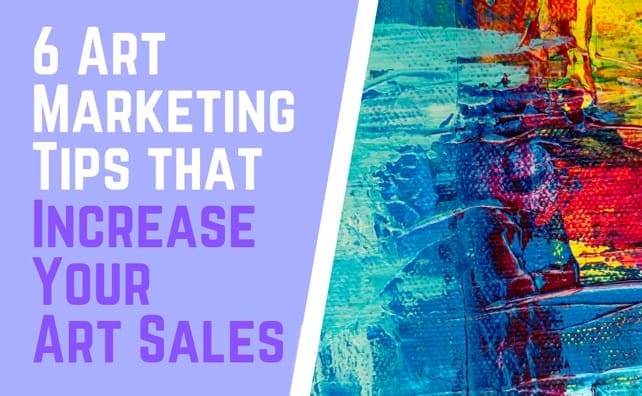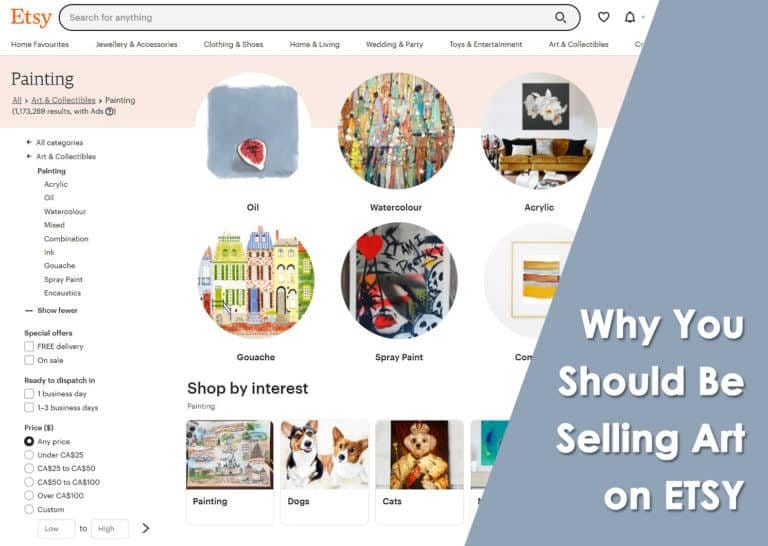
Welcome to the world of art pricing! As an emerging artist, determining the right price for your artwork can be a daunting task. In this guide, we will cover various strategies to help you decide how to price art with confidence. Keep in mind that there’s no one-size-fits-all approach, but understanding the basics will set you on the right path.
The importance of pricing artwork correctly

Pricing your artwork accurately is an essential part of your Art Business strategy for several reasons:
An example of an artist who has successfully navigated the art of pricing is Shepard Fairey. His carefully planned pricing strategy helped him gain credibility and recognition in the art world.
Common challenges faced by beginner artists
As a beginner artist, you may face several challenges when pricing your artwork:
- Lack of confidence in your skills and the value of your art.
- Insufficient knowledge of the art market and its dynamics.
- Fear of overpricing or underpricing your work.
Don’t worry, this guide will help you overcome these challenges and develop a well-informed pricing strategy.
Understanding the Art Market
Before diving into pricing techniques, it’s essential to grasp the intricacies of the art market. Familiarizing yourself with its key players and how they operate will provide context for your pricing decisions.

Types of Buyers in the Art Market
There are various types of art buyers, each with different motivations and expectations. Some common categories include:
- Art Collectors: They acquire art as an investment or to expand their personal collections. They typically seek high-quality, unique pieces and are often willing to pay a premium for them.
- Interior Designers: They purchase art to complement their clients’ design projects. They may prioritize aesthetics and affordability over the artist’s reputation or the artwork’s potential appreciation.
- Casual Buyers: These are individuals who buy art to decorate their homes or as gifts for friends and family. They often focus on the visual appeal of the artwork and may have a limited budget.
Understanding the different types of buyers can help you tailor your pricing strategy and marketing efforts to attract the right audience.
Factors Influencing the Value of Art
Several factors can impact the perceived value of your artwork, such as:
For example, artworks by established artists like Banksy command higher prices due to their widespread recognition, unique style, and the artist’s reputation.
The Role of Galleries, Agents, and Art Consultants
Galleries, agents, and art consultants can play a significant role in promoting and selling your artwork. They often have extensive knowledge of the market and can help you reach a broader audience. However, working with these intermediaries usually involves sharing a percentage of your sales as a commission.
Some useful resources for finding and working with galleries and agents include:
- Artsy: A platform for discovering and connecting with galleries, artists, and collectors.
- Art Business: A website offering advice and guidance on various aspects of the art business, including working with galleries and agents.
By understanding the dynamics of the art market and its key players, you’ll be better equipped to make informed decisions about your pricing strategy.
Assessing Your Own Artwork

Before you can price your artwork, it’s essential to assess its value and position within the market. This requires an honest evaluation of your work and a clear understanding of your artistic niche.
Identifying Your Unique Selling Points
Every artist brings something unique to the table. Identifying your strengths and what sets your artwork apart from others will help you communicate your value to potential buyers. Consider factors such as:
- Your artistic style and technique.
- The themes and subjects you explore.
- Your personal story and connection to your art.
For example, Yayoi Kusama is known for her distinctive use of polka dots and immersive installations, which has contributed to her widespread recognition and high market value.
Determining your Artistic Niche and Target Audience
Identifying your artistic niche and target audience will enable you to better position your artwork in the market. Think about the following:
- The genres and styles your artwork fits into.
- The demographics and interests of your potential buyers.
For example, if your artwork focuses on nature themes and you use eco-friendly materials, your target audience might be environmentally-conscious art collectors.
Comparing your artwork to similar pieces in the market
Researching similar artists and artwork can provide valuable insights into market trends and pricing benchmarks. Keep in mind that it’s essential to compare your work to pieces that are truly similar in terms of quality, style, and reputation. Some platforms for researching artwork prices include:
- Artnet: Offers access to a database of auction results and artist profiles.
- Artsy: Allows you to browse and compare artworks for sale from various galleries and artists.
Understanding your own artwork’s value and positioning will provide a solid foundation for determining your pricing strategy.
Cost-Based Pricing Strategy

One common method for pricing artwork is to use a cost-based approach, which takes into account your production costs, labor, and desired profit margin. This method ensures that you cover your expenses and earn a fair income from your art sales.
Start by calculating the cost of materials used in creating your artwork, such as paint, canvas, and framing. Also, consider overhead costs like studio rent, utilities, and marketing expenses. Divide these overhead costs by the number of artworks you produce annually to get a per-piece overhead cost.
Next, determine the amount of time spent on creating each artwork and decide on an hourly wage for your labor. Multiply the hours spent on the artwork by your hourly wage to get the labor cost for each piece.
Setting a Desired Profit Margin
Finally, add your material, overhead, and labor costs, and then apply a desired profit margin (typically between 20% and 50%) to determine your final selling price.
While cost-based pricing is a straightforward method, it’s essential to consider other factors like market demand, perceived value, and competition to ensure your pricing strategy aligns with the broader art market.
Demand-Based Pricing Model

Another approach to pricing your artwork is demand-based pricing, which focuses on the market’s willingness to pay for your art. This method requires a good understanding of market trends and the preferences of your target audience.
Analyzing market demand for your artwork
To analyze market demand, research trends in your artistic niche and gather feedback from potential buyers. You can use online platforms like Artsy and Artfinder to explore the popularity of different styles and genres.
Based on your market research, adjust your pricing to align with what buyers are willing to pay for similar artworks. This might involve raising or lowering your prices, depending on the current demand for your style and subject matter.
Recognizing seasonal trends and fluctuations
Art sales can be influenced by seasonal trends and events, such as holidays or art fairs. Keep an eye on these fluctuations and consider adjusting your pricing strategy accordingly. For example, you might offer a limited-time discount during the holiday season to attract more buyers.
Demand-based pricing can help you stay in tune with market dynamics and ensure your artwork is priced competitively. However, it’s crucial not to undervalue your work or compromise your artistic integrity in the pursuit of higher sales. Balancing demand-based pricing with other pricing strategies, such as cost-based and value-based approaches, will lead to a more comprehensive and effective pricing strategy for your artwork.
Value-Based Pricing

Value-based pricing focuses on the perceived value of your artwork in the eyes of potential buyers. This approach considers factors like emotional connection, uniqueness, and the story behind your art. Value-based pricing can help you capture the intangible elements that make your work special and appeal to your target audience.
Understanding the emotional connection to your artwork
Art often has an emotional impact on buyers, who may connect with your work on a personal level. To tap into this emotional connection, think about the feelings and experiences your art evokes and how you can communicate this to potential buyers.
For example, if your artwork explores themes of love and relationships, emphasize this in your marketing materials and artist statement.
Highlighting the uniqueness of your work
Buyers are often drawn to artworks that offer something different and unique. Showcase the elements that set your work apart from others, such as innovative techniques, unusual materials, or a distinctive visual style. By emphasizing your artwork’s unique qualities, you can command a higher price based on its perceived value.
Sharing the story behind your art can create a deeper connection with potential buyers and add value to your work. Provide context for your artwork by discussing your creative process, inspiration, and personal experiences that inform your art. Including this information in your artist statement or marketing materials can help buyers understand and appreciate the value of your work.
Value-based pricing allows you to capitalize on the intangible aspects of your artwork that may not be reflected in cost-based or demand-based pricing methods. By considering the emotional connection, uniqueness, and story behind your art, you can create a pricing strategy that captures the true value of your work and resonates with your target audience.
Competitive Pricing

When pricing your artwork, it’s essential to consider the prices of similar artists and artwork within the market. By understanding your competition, you can create a pricing strategy that balances affordability with perceived value.
To get a sense of how your artwork should be priced, research the prices of other artists with comparable styles, techniques, and experience levels. Online platforms like Artsy and Artfinder can help you browse and compare prices from various artists and galleries. Beginners starting out selling their artwork can look at similar art listed on Etsy to get an idea of pricing.
Identifying your competitive advantages and disadvantages
Take note of your strengths and weaknesses compared to other artists in your niche. Perhaps your technique is highly skilled, or your artwork is created using sustainable materials. These competitive advantages can justify a higher price for your work. Conversely, if you’re new to the art world or have a limited exhibition history, you may need to price your work more modestly to attract buyers.
Striking a balance between affordability and perceived value is key to a successful pricing strategy. If your prices are too high, buyers may be deterred, while prices that are too low can lead to undervaluing your work. Aim to price your artwork competitively while maintaining a fair reflection of its quality and uniqueness.
Pricing Artwork for Different Formats and Editions
The format and edition of your artwork can significantly impact its value and pricing. Understanding how to price original artwork, prints, and digital art can help you maximize your earnings across different formats.

Pricing original artwork vs. prints
Original artwork is typically priced higher than prints due to its uniqueness and the time and effort involved in its creation. Prints, on the other hand, are more affordable for buyers since they are reproductions and can be produced in larger quantities. When pricing prints, consider the quality of the materials, the size, and the edition size.
The impact of edition size and scarcity
The size of an edition can greatly influence the value of a print. Limited edition prints are more valuable than open edition prints because they are more scarce and exclusive. For example, a print from an edition of 50 will generally be more valuable than a print from an edition of 500.
Adjusting prices for digital artwork
Digital artwork, such as digital paintings, illustrations, or NFTs (Non-Fungible Tokens), requires a different pricing approach. Since digital art can be reproduced infinitely, consider factors like uniqueness, file size, resolution, and potential licensing agreements when determining your prices. Offering limited edition digital artwork or NFTs can also help increase their perceived value and justify higher prices.
Understanding how to price your artwork across different formats and editions is essential for maximizing your income potential and ensuring your pricing strategy remains competitive in the ever-evolving art market.
The Role of Experience and Reputation
Your experience and reputation as an artist play a significant role in determining the value of your artwork. As you gain recognition and build a strong artistic CV, you can adjust your pricing to reflect your growing stature in the art world.
An impressive artistic CV, which includes factors like education, exhibitions, awards, and media coverage, can enhance your credibility and justify higher prices for your artwork. A strong CV demonstrates your commitment to your craft and the value of your work, making it easier for potential buyers to justify the investment.
The Impact of Awards, exhibitions, and media coverage

Receiving awards, participating in prestigious exhibitions, and securing media coverage can significantly boost your reputation as an artist. These accomplishments validate your work in the eyes of buyers, collectors, and art professionals, allowing you to command higher prices for your artwork.
Building a strong personal brand as an artist
Developing a strong personal brand is essential for distinguishing yourself from other artists and building a loyal following. By consistently producing high-quality work, engaging with your audience, and sharing your creative journey, you can cultivate a unique artistic identity that adds value to your work and supports higher pricing.
Negotiating Artwork Prices
Negotiation is an inevitable part of selling artwork and understanding the psychology of negotiation can help you navigate these discussions with confidence while maintaining the value of your work.

Buyers may use various negotiation tactics to secure a lower price for your artwork, such as making a low initial offer or expressing doubts about the value of your work. Familiarize yourself with common negotiation tactics and prepare counterarguments to maintain control of the conversation and defend your pricing.
Anticipate potential objections from buyers, such as concerns about the artwork’s price, size, or subject matter. By preparing responses to these objections in advance, you can confidently address buyer concerns and reassure them of the value of your work.
Before entering a negotiation, establish your pricing boundaries, including the minimum price you’re willing to accept for your artwork. Knowing your limits will help you maintain control of the negotiation and avoid compromising the value of your work.
Mastering the art of negotiation is crucial for protecting your artwork’s value and ensuring you receive fair compensation for your efforts. By understanding the psychology of negotiation, preparing for buyer objections, and setting clear pricing boundaries, you can confidently navigate discussions and secure the best possible outcome for your art sales.
Offering Discounts and Incentives
Offering discounts and incentives can help attract new buyers and encourage repeat business. However, it’s essential to strike a balance between providing incentives and maintaining the perceived value of your artwork.
Consider offering discounts during special promotions, seasonal sales, or to reward loyal customers. Flexible payment options, such as installment plans, can also make your artwork more accessible to a broader audience without directly lowering the price.
Creating loyalty programs for repeat buyers
Develop loyalty programs to reward your most dedicated collectors and encourage repeat purchases. These programs could include exclusive discounts, early access to new work, or special events and experiences for your most loyal supporters.
Partner with other artists or organizations to create unique promotional opportunities. Collaborative events, exhibitions, or limited edition releases can generate excitement among your audience and attract new buyers.
Documenting Your Pricing Strategy

Keeping detailed records of your pricing strategy, past sales, and market trends can help you track your progress and make informed decisions about your artwork pricing.
Maintain a record of all your past sales, including the artwork details, sale price, and buyer information. This information can help you analyze your pricing strategy’s effectiveness and identify patterns in your sales history.
Regularly review your sales data to assess the success of your pricing strategy. Look for trends in your sales volume, average sale price, and buyer feedback to determine if your pricing is meeting your financial goals and resonating with your audience.
Adjusting prices based on market trends and feedback
Stay informed about market trends, competitor pricing, and buyer preferences to make data-driven adjustments to your pricing strategy. This approach allows you to respond to changing market conditions and maintain a competitive edge.
Documenting your pricing strategy and monitoring its success will help you make more informed decisions about your artwork pricing. By keeping detailed records, staying informed about market trends, and adjusting your prices based on feedback, you can create a dynamic pricing strategy that supports your artistic growth and financial goals.
Working with Galleries and Art Dealers
Collaborating with galleries and art dealers can provide valuable exposure for your artwork and help you connect with new buyers. Navigating gallery pricing structures and negotiating mutually beneficial agreements is essential for a successful partnership.
Galleries typically charge a commission on artwork sales, often ranging from 40% to 50%. Familiarize yourself with gallery commission structures and adjust your artwork pricing accordingly to account for these fees.
When working with galleries or art dealers, negotiate pricing agreements that benefit both parties. Ensure that your pricing structure allows for gallery commissions while still providing you with fair compensation for your work.
Pricing artwork for Art Fairs and Exhibitions

Art fairs and exhibitions can be valuable sales opportunities and may require specific pricing strategies. Consider factors like booth fees, shipping costs, and the competitive landscape when pricing your artwork for these events.
Working with galleries, and art dealers, and participating in art fairs can provide valuable exposure and sales opportunities for your artwork. Understanding gallery pricing structures, negotiating favorable agreements, and adapting your pricing strategy for specific events will help you maximize these opportunities and ensure the best possible outcome for your art sales.
Final Thoughts on How to Price Your Art

As an artist, it’s crucial to regularly evaluate and refine your pricing strategy to ensure it remains effective and aligned with your goals. Continuously monitoring market trends, buyer feedback, and sales performance will help you make informed decisions and adapt to the evolving art market.
Pricing artwork can be challenging, especially for beginners. Embrace the learning process, be open to experimenting with different pricing strategies, and seek guidance from experienced artists and industry professionals. Over time, you’ll develop a pricing strategy that works for you and supports your artistic growth.






